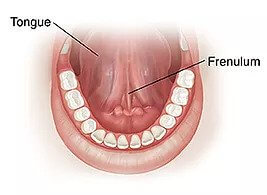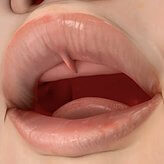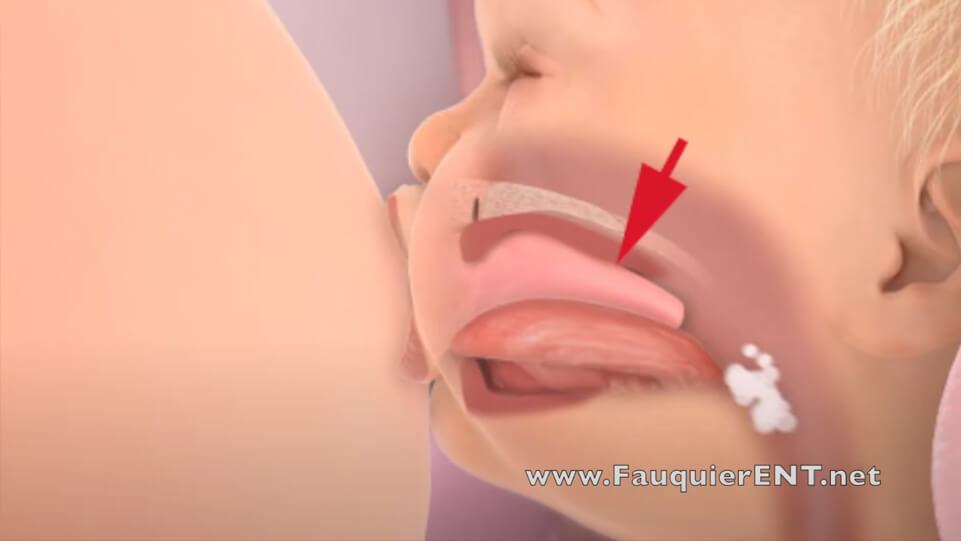INFANT TONGUE TIES “Baby tongue tie symptoms and treatments”
INFANT TONGUE TIE (LINGUAL FRENULUM)
Tongue tie, commonly referred to as Ankyloglossia, is a string of tissue called frenulum. This frenulum connects the underside of the tongue to the mouth’s floor and can be seen under the tongue through a mirror. The frenulum tissue can restrict the movements of the tongue and cause problems during Breastfeeding, Sucking, Swallowing, Eating and Chewing, Drinking, Breathing, Speech, Jaw growth, Posture and Digestion.

INFANT LIP TIE (LABIAL FRENULUM)
Infant lip ties are a similar band of tissue called the labial frenulum that adheres the lip to the gums at a level much higher than normal. This can lead to potential breastfeeding issues, a gap in between upper front teeth, cavities, inability to close the lips without strain, and speech difficulties.

BABY TONGUE TIE CAUSES
While there are various theories and research behind it, the exact causes of tongue ties are not known yet. Researchers suggest that the tongue tie may be hereditary or due to a defect in cellular apoptosis. Additionally, boys have been found to be more susceptible to having a tongue tie.
SYMPTOMS OF A TONGUE TIE IN INFANTS
Breastfeeding in infants is essential not only for weight gain but also for developed tongue function for the correct functioning of the jaw. Unsuccessful breastfeeding is often stressful for the mother and may affect her mental health. Unsuccessful breastfeeding may prompt the mother to use supplement bottles under the notion that she’s not producing enough milk. However, in certain cases, this may not be true. At times, there may be dysfunctions with the baby’s soft tissues that can be easily resolved. A failure to diagnose tongue and lip ties supplemented with bottle feeds affects jaw growth, airway development, and much more. For mothers having trouble breastfeeding, it would be ideal to meet with a pediatric dentist, lactation consultant, or pediatrician who can rule out lactation concerns and then assess if there is any tongue or lip tie that is hindering the process of breastfeeding. A comprehensive team-based approach is key to treating these patients. At TMJ, Tongue Tie & Sleep Institute, we also believe in helping a mother through their exhausting breastfeeding journey with emotional and psychological support.
Breast Feeding Mother Symptoms
Symptoms in breastfeeding mothers indicating baby tongue tie includes the following,
Creased nipples
Blanched nipples
Incomplete breast drainage after feeding
Mastitis / Infected nipples
Nipple Thrush
Reduced milk supply
State of mind: Anxious / Depressed
Baby Tongue Tie Symptoms
The various baby tongue tie symptoms to watch out for includes the following,
Prolonged latching / long feeding hours
Unsettled after feeding
Poor / shallow latch
Chewing on nipples
Reflux symptoms
Colic symptoms / Gassiness
Falls asleep during feeds
Pulls body away from breast while feeding
INFANT TONGUE TIE DIAGNOSIS
In many cases, infant tongue tie is found when determining the cause of breastfeeding problems in the baby. A tongue tie cannot be diagnosed by seeing if the newborn can stick out the tongue outside the mouth. The evidence-based current approach shows that a a comprehensive functional assessment of the tongue is essential. For accurate infant tongue tie diagnosis, it is essential to see a tongue tie specialist. This is also important because apart from the appearance of the tongue, various other tongue tie symptoms can be assessed only by a trained tongue tie specialist.
INFANT TONGUE TIE TREATMENT
The baby’s history
Clinical examination
The severity of the condition
In severe cases, a frenotomy is advised. It can be performed using a scissor or laser technique. The Laser Frenectomy is a safe, quick, simple, and painless procedure that generally requires no anesthesia. Oral Myofunctional Therapy is given as an adjunct to rehabilitate the tongue function and avoid any relapses. In some infants, Craniosacral Therapy may be used as an adjunct when some asymmetry in the head shape or problems with neck stabilization and body tightness have been observed. Postoperative stretches, a functional release, and a team approach is the key to a successful frenotomy. This is what sets us apart. For those seeking tongue tie treatment near me, you have come to the right place. Tongue Tie Treatment Near Me
Blogs


























